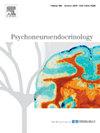不要排除你的观察结果:负皮质醇唤醒反应(CAR)可能与生物学相关
IF 3.4
2区 医学
Q2 ENDOCRINOLOGY & METABOLISM
引用次数: 0
摘要
皮质醇觉醒反应(CAR)是指从睡眠中醒来后 30-40 分钟内皮质醇浓度的变化,常用于压力研究。由于预期皮质醇觉醒反应为正值,我们假设负值可能与潜在的健康状况(反映在血液学参数中)或环境暴露有关,如铅(Pb),铅对神经内分泌有影响,包括改变皮质醇的昼夜节律。我们的目的是分析孕妇(900 人)中负 CAR 值的发生率及其与血液学参数和血液中铅(BPb)水平的关系。通过发光免疫测定法对两天唾液样本中的皮质醇进行测量。CAR是根据每个采集日的第一次(唤醒时)和第二次(唤醒后 45 分钟)皮质醇浓度之间的差值估算的,可操作为:两天均为阳性(CAR-PP,23%),任何一天均为阴性(CAR-NP/PN,40%),两天均为阴性(CAR-NN,37%)。使用库尔特血液分析仪进行全血细胞计数。BPb 采用电感耦合等离子体质谱法进行分析。使用调整后的多项式逻辑回归模型分析了血液学变量与 CAR 组别之间的关联。对概率进行了估计,以评估 BPb 和血液学变量对 CAR 组间的影响。第一采集日的 CAR 中位数(第 25 位,第 75 位)为 -2.76 nmol/L (-16.55, 14.62),第二采集日为 -4.14 nmol/L (-17.66, 13.24)。白细胞、嗜酸性粒细胞、嗜碱性粒细胞和 BPb 浓度较高的妇女更有可能属于 CAR-NN 或 CAR-NP/PN 组。与 CAR-PP 妇女相比,CAR-NP/PN 和 CAR-NN 妇女的白细胞水平呈负相关,嗜碱性粒细胞浓度较高。我们的结论是,阴性 CAR 值可能是潜在健康状况的指标,也可能与环境暴露(如铅)有关。研究应考虑在分析中排除阴性 CAR 值之前对其进行全面评估。本文章由计算机程序翻译,如有差异,请以英文原文为准。
Do not exclude your observations: Negative cortisol awakening responses (CAR) may be biologically relevant
The Cortisol Awakening Response (CAR) is the change in cortisol concentrations within 30–40 minutes after waking from sleep and is frequently used in stress research. Since a positive CAR is expected, we hypothesized that negative values could be associated to an underlying health condition (reflected in hematological parameters) or to environmental exposures such as lead (Pb), which has neuroendocrine effects including altered cortisol diurnal rhythms. Our aim was to analyze the prevalence of negative CAR values and their association with hematological parameters and blood Pb (BPb) levels in pregnant women (n = 900). Cortisol was measured by luminescence immunoassay in two-day saliva samples. CAR was estimated as the difference between the first (time of awakening) and second (45 min after) cortisol concentrations for each collection day and was operationalized as: both days positive (CAR-PP, 23 %), either day with a negative (CAR-NP/PN, 40 %), and both negative (CAR-NN, 37 %). A complete blood count was done using a coulter hematology analyzer. BPb was analyzed by inductively coupled plasma-mass spectrometry. Associations between hematological variables and CAR groups were analyzed using adjusted multinomial logistic regression models. Probabilities were estimated to assess the influence of BPb and hematological variables between CAR groups. The median (25th, 75th) CAR for the first collection day was −2.76 nmol/L (-16.55, 14.62) and −4.14 nmol/L (-17.66, 13.24) for the second day. Women with higher concentrations of leukocytes, eosinophils, basophils, and BPb were more likely to belong to CAR-NN or CAR-NP/PN groups. Compared to women with CAR-PP, those with CAR-NP/PN and CAR-NN had inverse associations for leukocyte levels and higher BPb concentrations. We conclude that negative CAR values could be an indicator of an underlying health condition or associated with environmental exposures such as Pb. Research should consider a thorough assessment of negative CAR values before excluding them from analyses.
求助全文
通过发布文献求助,成功后即可免费获取论文全文。
去求助
来源期刊

Psychoneuroendocrinology
医学-精神病学
CiteScore
7.40
自引率
8.10%
发文量
268
审稿时长
66 days
期刊介绍:
Psychoneuroendocrinology publishes papers dealing with the interrelated disciplines of psychology, neurobiology, endocrinology, immunology, neurology, and psychiatry, with an emphasis on multidisciplinary studies aiming at integrating these disciplines in terms of either basic research or clinical implications. One of the main goals is to understand how a variety of psychobiological factors interact in the expression of the stress response as it relates to the development and/or maintenance of neuropsychiatric illnesses.
 求助内容:
求助内容: 应助结果提醒方式:
应助结果提醒方式:


